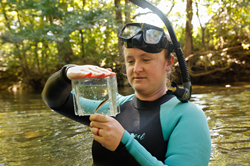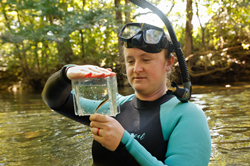
Tennessee Aquarium Conservation Institute Recovery Biologist Shawna Fix holds a portable aquarium with a Bridled Darter collected from Holly Creek in North Georgia.
“The Tennessee Aquarium has always focused on the rivers and streams of the Southeast. Opening this freshwater science center five years ago has allowed us to expand our impact across the region.” – Dr. Anna George, the Aquarium’s VP of conservation science and education
CHATTANOOGA, Tenn. (PRWEB)
October 27, 2021
From its solar water heater and rainwater collection cistern to the buzzing meadow of native plants that serves as its front yard, everything about the Tennessee Aquarium’s state-of-the-art field station resonates with its commitment to the environment and freshwater conservation.
Since opening its doors on Oct. 27, 2016, this 14,000-square-foot, $6 million facility has served as the Tennessee Aquarium Conservation Institute (TNACI) headquarters. The Conservation Institute existed long before this grand opening, but having a dedicated facility to serve as the nexus of the Aquarium’s conservation efforts was an important moment in its mission to protect freshwater.
“The Aquarium had always wanted to invest more heavily in our conservation efforts,” says Dr. Anna George, the Aquarium’s vice president of conservation science and education. “We’ve always focused on the rivers and streams of the Southeast. That made us unique among other aquariums, and opening this facility allowed us to expand our impact.
“It was important to all of us that we not only displayed and celebrated these animals but also did something to protect them.”
In the first five years of operation at the new facility, TNACI staff have tackled a sweeping scientific agenda, from spawning nearly extinct freshwater fish and evaluating the conservation status of Alligator Snapping Turtles to studying the impact of microplastic debris on rivers and streams.
As the epicenter of the Aquarium’s conservation work celebrates its first significant anniversary, however, its scientists haven’t slowed their pace. During the summer and fall, TNACI staff juggled many active projects alongside partnering organizations and agencies throughout the region.
In September, TNACI biologists and Aquarium staff donned wetsuits and snorkels to evaluate the health of Bridled Darters in Holly Creek in the Northeast Georgia foothills. In addition to surveying the Bridled Darters’ population size, scientists also collected fin samples that were sent to the University of West Alabama for further analysis. Combined, these data will help scientists determine if this rare fish warrants listing as an endangered species in years to come.
Two weeks later, TNACI’s crew was in the field (and submerged) again, this time in the pristine waters of the Tellico River near Tellico Plains, Tenn. On this occasion, they were in pursuit of charismatic, colorful Tangerine Darters. These enormous — for a darter, at least — freshwater fish aren’t of any particular conservation concern, but they have an essential role to play in saving another endangered Tennessee native: the Cracking Pearlymussel.
Like more than 70 percent of all Southeastern freshwater mussels, Cracking Pearlymussels are endangered and at risk of extinction in the next 100 years. Mussels are especially sensitive to changes in water quality and have seen a massive decline in their populations in recent decades due to habitat degradation caused by human activity.
The mussel life cycle requires the help of freshwater fish through a beautifully bizarre interaction that aids in their dispersal through rivers. Female mussels that are ready to release their larvae (baby mussels) draw in specific fish species, sometimes using astonishingly elaborate lures. This biological smoke and mirrors display takes various forms, from mimicking the fish’s prey to imitating the enticing motions of a potential mate.
Once near enough, the mussels infect the duped fish with their larvae, either by clamping their shell closed around their target or releasing their offspring in an unavoidable cloud. After harmlessly attaching to the fish’s gills, the larvae use it as a kind of underwater Lyft service. After a few days’ ride, they detach and sink to the waterway’s bottom, enabling the otherwise sedentary mollusks to colonize new areas.
Cracking Pearlymussels are uniquely adapted to use Tangerine Darters to expand their range. The Tangerine Darters that TNACI scientists collected from the Tellico will spend the winter at the Aquarium’s field station and will be spawned in the spring. Any produced offspring will be sent to the Cumberland River Aquatic Center, a Tennessee Wildlife Resources Agency (TWRA) mussel propagation and restoration facility near Nashville.
This work is being carried out during a crucial period in freshwater mussel conservation. In September, the U.S. Fish and Wildlife Service proposed a declaration of extinct status for 23 American animals, including nine mussel species, six of which are native to Tennessee. USFWS has listed another 51 mussel species in Tennessee as endangered or threatened under the Endangered Species Act.
“Freshwater mussels are ecologically and economically important,” says Dr. Dan Hua, TWRA senior scientist, and manager of the River Center. “As filter feeders, they ‘clean’ the water by removing suspended particulates, detritus, and harmful elements.
“In addition, freshwater mussels … are recognized as useful indicators of water quality.”
In addition to launching new projects and partnerships, TNACI’s headquarters is also the heart of long-term programs to raise, release and restore iconic Southeastern species such as the Southern Appalachian Brook Trout and Lake Sturgeon.
This summer, the Aquarium and its partners began stocking a new Appalachian stream with Brook Trout that were spawned and raised at the TNACI field station. On the last day of summer, a team from TWRA hand-delivered ten new adult “Brookies” to the Aquarium’s field station. These fish, collected from Brookshire Creek in the Cherokee National Forest, will add their unique genetics to the juveniles released into the new stream next year.
The restoration effort, which TNACI joined in 2012, dates back to the 1980s. At the time, genetically distinct Southern Appalachian Brook Trout had all but disappeared from their range due to competition with introduced species and poor logging practices that degraded native streams. Scientists also remain concerned about the effect of changing temperature and precipitation patterns on Brook Trout’s future prospects in the region.
The decision to shift restocking efforts to a new stream system this year was reached because previous release sites now host self-sustaining populations. This is an important milestone in the effort to bring Brook Trout back to the Southern Appalachians, says TNACI Reintroduction Biologist Sarah Kate Bailey.
“That shows that our reintroduction program has been successful,” she says. “Adding new broodstock to our current adult trout population ensures we will be adding genetic diversity to these streams, which is a key component of a healthy population.”
On Oct. 7, the Aquarium and other Lake Sturgeon Working Group members celebrated the latest release of juvenile Lake Sturgeon into Watts Bar Reservoir near Kingston, Tenn. This year is the 22nd in the marathon effort to reintroduce these native river giants to the Tennessee River and other Southeastern waterways.
With winter-bare branches still scraping the skies in central Wisconsin this April, TNACI scientists made the 800-mile drive to the Wolf River to help collect and fertilize eggs from wild-spawning Lake Sturgeon. Weeks later, juvenile Lake Sturgeon were sent to the Conservation Institute. They spent the summer months growing to a releasable size of about six inches.
The Wolf River’s still-healthy population of Lake Sturgeon stands in stark contrast to the Tennessee River. Lake Sturgeon had disappeared by the 1970s due to a combination of overfishing, river damming, and low water quality.
The 650 juvenile Lake Sturgeon released earlier this month resulted from the Wolf River spawning and are welcome transplants to the Southeast. Their introduction to the river marks the latest chapter of a project started in the mid-1990s when improvements to the health of the Tennessee River suggested a restoration was possible.
In all, more than 250,000 Lake Sturgeon have been released into the Tennessee River and other Southeastern waterways since 2000. Of these, more than 30,000 (about one in nine of those released) were raised by the Aquarium. Even after all this time, however, the work by TNACI and its partners will remain important for the foreseeable future, says TNACI Aquatic Conservation Biologist Dr. Bernie Kuhajda.
“These are long-lived animals — some can reach 150 years old — so it’s a long-term commitment to restore them,” he says. “It takes 20 years, at least, before females are ready to spawn for the first time, and we’re getting near that time when the first sturgeon we released will have reached that point. When that happens in the Tennessee River, it’ll be an amazing event.”
Learn more about the history of the Conservation Institute’s flagship science facility.
Learn more about the Tennessee Aquarium’s conservation efforts.

